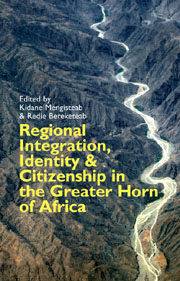Book contents
- Frontmatter
- Contents
- List of Tables, Figures & Appendices
- Notes on Contributors
- Acknowledgements
- List of Acronyms
- Part One RELEVANCE OF INTEGRATION TO IDENTITY AND CITIZENSHIP
- Part Two CRITICAL FACTORS IN INTEGRATION
- 4 Invisible Integration in the Greater Horn Region
- 5 Nationalist, Sub-nationalist, and Region-wide Narratives and the Quest for Integration-promoting Narratives in the Greater Horn Region
- 6 Infusion of Citizenship, Diversity and Tolerance in the Education Curriculum: Promoting Regional Integration and Peace in the Greater Horn Region
- 7 Radio and the Propagation of Anti- and Pro-Ethiopian Narratives in Somalia
- Part Three LESSONS FROM SELECTED AFRICAN INTEGRATION SCHEMES
- Index
- EASTERN AFRICAN STUDIES
4 - Invisible Integration in the Greater Horn Region
from Part Two - CRITICAL FACTORS IN INTEGRATION
Published online by Cambridge University Press: 05 February 2013
- Frontmatter
- Contents
- List of Tables, Figures & Appendices
- Notes on Contributors
- Acknowledgements
- List of Acronyms
- Part One RELEVANCE OF INTEGRATION TO IDENTITY AND CITIZENSHIP
- Part Two CRITICAL FACTORS IN INTEGRATION
- 4 Invisible Integration in the Greater Horn Region
- 5 Nationalist, Sub-nationalist, and Region-wide Narratives and the Quest for Integration-promoting Narratives in the Greater Horn Region
- 6 Infusion of Citizenship, Diversity and Tolerance in the Education Curriculum: Promoting Regional Integration and Peace in the Greater Horn Region
- 7 Radio and the Propagation of Anti- and Pro-Ethiopian Narratives in Somalia
- Part Three LESSONS FROM SELECTED AFRICAN INTEGRATION SCHEMES
- Index
- EASTERN AFRICAN STUDIES
Summary
INTRODUCTION
As noted in chapter 1, the Greater Horn Region (GHR) comprises eleven countries – Burundi, Djibouti, Eritrea, Ethiopia, Kenya, Rwanda, Somalia, Sudan, South Sudan, Tanzania and Uganda. However, for the purposes of this chapter, the GHR constitutes Djibouti, Eritrea, Ethiopia, Kenya, Somalia, South Sudan, Sudan and Uganda. The aim of this chapter is (1) to theorize the hitherto-neglected key concept of invisibility; (2) to present a typology of invisible populations in the region; (3) to analyse and evaluate how transmigrants (pastoralists, agro-pastoralists, cross-border traders, wage-labourers and the like), the multiple sub-categories of asylumseekers, as well as refugees and those who fail to ‘vote with their feet’ homewards after the cessation of the factors that prompted them to flee, deploy invisibility as a weapon to defy the sovereign power of the state in terms of determining who should enter into or exit from its territory and who should form bonds of community and on what terms and conditions within that territory; and (4) to identify the principal catalysts that facilitate informal integration of invisible populations in the GHR.
THEORISING INVISIBILITY
The aim of this part is to theorize the concept of invisibility which has hitherto escaped the attention of analysts. It is a key concept employed in the chapter to explain the process and outcome of the informal integration that has been taking place throughout the GHR.
- Type
- Chapter
- Information
- Publisher: Boydell & BrewerPrint publication year: 2012

